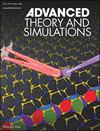利用深度特征嵌入和机器学习模型从扫描电镜图像中估计纳米纤维直径
IF 2.9
4区 工程技术
Q1 MULTIDISCIPLINARY SCIENCES
引用次数: 0
摘要
在材料科学中,精确的纳米纤维直径估算对于优化其功能至关重要。传统的扫描电子显微镜(SEM)图像测量方法往往是劳动密集型和主观的。本研究提出了一种基于机器学习的方法,使用深度特征嵌入直接从扫描电镜图像中预测纳米纤维的平均直径。八种机器学习模型——线性回归(LR)、k近邻(kNN)、决策树(DT)、随机森林(RF)、支持向量机(SVM)、神经网络(NN)、梯度增强(GB)和adaboost——使用5倍和10倍交叉验证进行评估。通过均方误差(MSE)、均方根误差(RMSE)、平均绝对误差(MAE)、平均绝对百分比误差(MAPE)和R2来评估性能。kNN模型在三个数据集上的表现始终优于其他模型:光滑纳米纤维、串珠纳米纤维和组合纳米纤维。对于光滑的纳米纤维图像,它达到了最低的误差指标和最高的R2(0.950),同时显示出很强的跨形态泛化。这项研究是第一个将深度特征嵌入与机器学习相结合,直接预测纳米纤维直径的研究,为传统方法提供了可靠的替代方案。本文章由计算机程序翻译,如有差异,请以英文原文为准。

Novel Estimation of Nanofiber Diameter from SEM Images Using Deep Feature Embeddings and Machine Learning Models
Accurate nanofiber diameter estimation is crucial for optimizing their functionality in materials science. Traditional measurement methods from Scanning Electron Microscopy (SEM) images are often labor-intensive and subjective. This study proposes a machine learning-based approach using deep feature embeddings to predict average nanofiber diameters directly from SEM images. Eight machine learning models—Linear Regression (LR), k-Nearest Neighbors (kNN), Decision Tree (DT), Random Forest (RF), Support Vector Machine (SVM), Neural Network (NN), Gradient Boosting (GB), and AdaBoost—are evaluated using 5-fold and 10-fold cross-validation. Performance is assessed via Mean Squared Error (MSE), Root Mean Squared Error (RMSE), Mean Absolute Error (MAE), Mean Absolute Percentage Error (MAPE), and R2. The kNN model consistently outperformed others across three datasets: smooth nanofibers, beaded nanofibers, and a combined set. It achieves the lowest error metrics and the highest R2 (0.950) for smooth nanofiber images while demonstrating strong generalization across morphologies. This study is among the first to integrate deep feature embeddings with machine learning for direct nanofiber diameter prediction, providing a reliable alternative to traditional methods.
求助全文
通过发布文献求助,成功后即可免费获取论文全文。
去求助
来源期刊

Advanced Theory and Simulations
Multidisciplinary-Multidisciplinary
CiteScore
5.50
自引率
3.00%
发文量
221
期刊介绍:
Advanced Theory and Simulations is an interdisciplinary, international, English-language journal that publishes high-quality scientific results focusing on the development and application of theoretical methods, modeling and simulation approaches in all natural science and medicine areas, including:
materials, chemistry, condensed matter physics
engineering, energy
life science, biology, medicine
atmospheric/environmental science, climate science
planetary science, astronomy, cosmology
method development, numerical methods, statistics
 求助内容:
求助内容: 应助结果提醒方式:
应助结果提醒方式:


